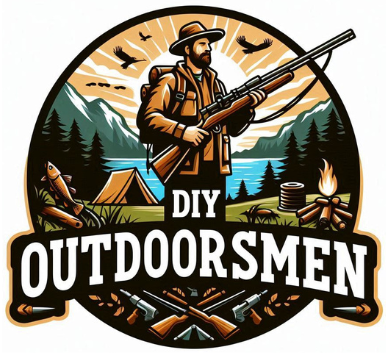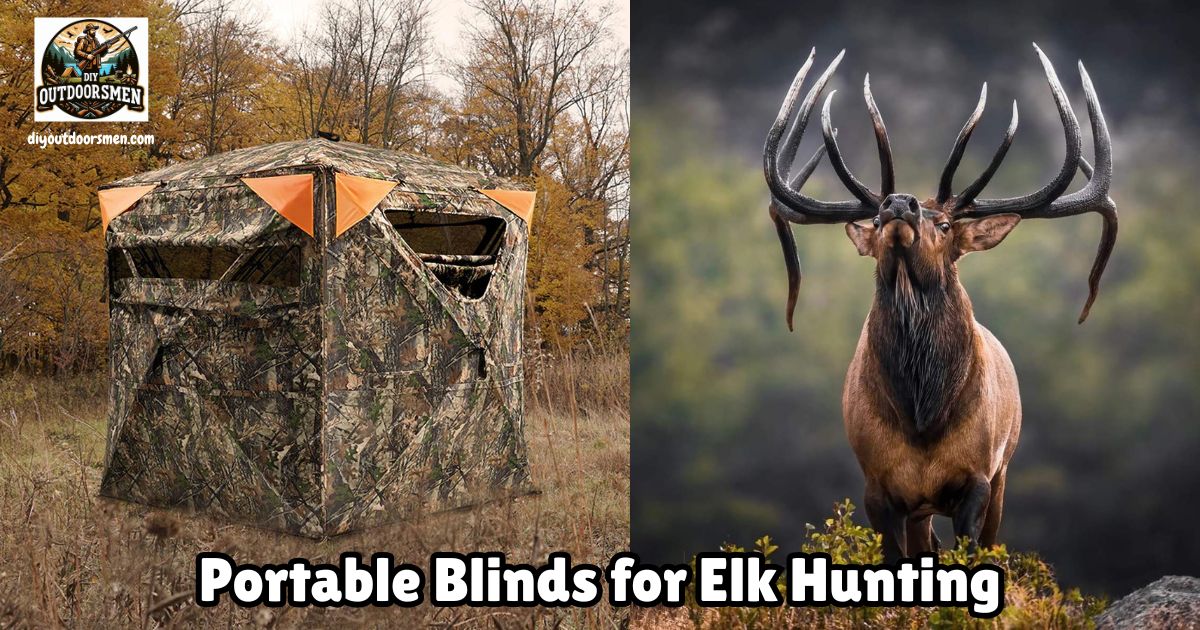Contents
- 1 Why Portable Blinds Make Sense for Elk Hunting
- 2 Key Strategies for Placing Your Portable Blind
- 3 Camouflage, Concealment, and Reducing Detection
- 4 Setting Up and Preparing Your Blind for Elk Hunting
- 5 Common Types of Portable Blinds for Elk Hunting
- 6 Popular Blinds I’ve Tried or Seen in the Field
- 7 More Portable Blind Tips for Elk Success
- 8 Frequently Asked Questions
- 9 Final Thoughts on Portable Blinds for Elk Hunting
Hunting elk from portable blinds can make your hunt more productive and comfortable. Getting the setup right plays a huge role in increasing your chances of seeing elk up close. Over the years, I’ve learned that following a practical approach to location, preparation, and concealment leads to the kinds of encounters elk hunters dream about. Here, I’ll lay out what I consider the top tips and strategies for finding success with portable blinds in elk country.
QUICK LOOK: Tips for Using Portable Blinds for Elk Hunting
- Blending with Natural Cover: After setup, I grab sticks, grass, and other local foliage and tuck or lean them against the blind. This breaks up any straight edges or odd shapes, making the blind look like part of the landscape.
- Set Up in Advance: If possible, I put the blind out a few days before hunting. Elk notice new objects in their world, so giving them time to get used to the blind pays off.
- Steer Clear of Skylines: I never set up on a ridge or spot where the blind is outlined against the sky. Placing it in front of trees or with brush behind reduces visibility for anything that might come by.
- Quiet Movements: Elk notice movement before color or shape, so keeping still is vital. I only move when there’s no choice, and make every motion slowly and deliberately.
- Shoot-Through Netting: Some blinds offer mesh window covers. These let me shoot without opening a dark gap, keeping me hidden even when I need to aim.
- Check for Light Leaks: Tiny cracks or open seams can draw elk’s attention. I patch these with spare camo fabric or clothespins, making sure the inside stays dark.
- Keep Windows Small: Wide-open windows are dead giveaways. I open them just enough for a clear line of sight and a good shot. Most blinds come with clips or straps for this.
- Comfortable Chair and Soft Floor: A quiet chair, like one that swivels or adjusts up and down, lets me change position without a sound. For the floor, a pad or mat cuts down noise and keeps me comfortable.
- Plan Entry and Exit: I map out how I’ll get to and from the blind quietly, always staying downwind and using natural cover. This keeps elk from being alerted to my presence, especially early or late in the day.
- Use a Rubber Mallet: Anchoring the blind spikes with a rubber mallet instead of a steel hammer makes far less noise, which is crucial with sharp-eared animals nearby.
Why Portable Blinds Make Sense for Elk Hunting
Elk are sharp-eyed, wary animals. Getting close to one on foot takes patience and luck, not to mention a careful approach. Portable blinds give me an edge, especially in areas where traditional spot and stalk tactics just don’t cut it—places with open parks, clearcuts, or near water sources.
Sitting in a blind allows me to settle in comfortably, wait out elk, and keep my movements to a minimum. These are big advantages when trying to outsmart such cautious animals. Portable blinds are especially useful for bowhunters.
Elk have powerful senses of smell and sight, so a blind helps conceal both my scent and movement. Sitting still for hours is much easier when I have shelter from the elements and a spot designed for comfort, especially in tough weather conditions.
Key Strategies for Placing Your Portable Blind
Where I set up my blind can really make or break my hunt. For a setup that’s both smart and effective, I focus on these core points:
- Elk Trails and Travel Routes: I study the woods for signs of elk movement—tracks, rubs, well-used trails, and crossings. Elk usually like to take the easiest route, so worn paths or low spots between ridges, known as saddles, are great places for a blind.
- Water and Feeding Areas: Since elk need water every day and mainly feed on fresh grass and forbs, setting up near a water source or a lush meadow with obvious sign can make a big difference.
- Wind Direction: Nothing matters more than the wind. I always put my blind downwind from where I expect elk to arrive. Even the best concealment won’t help if the wind blows my scent straight to the herd.
- Off to the Side: Rather than sitting smack on top of a trail or facing a trail directly, I set up off to the side. This way, elk are less likely to pick up on anything odd or stare directly at the blind as they pass by.
By working with natural elk movement and habits, I increase my odds for a close encounter.
Camouflage, Concealment, and Reducing Detection
Even the best blind stands out if it’s just plopped in an open spot. Getting it to blend in is key to success. Here’s how I make my blind practically invisible to elk:
- Blending with Natural Cover: After setup, I grab sticks, grass, and other local foliage and tuck or lean them against the blind. This breaks up any straight edges or odd shapes, making the blind look like part of the landscape.
- Set Up in Advance: If possible, I put the blind out a few days before hunting. Elk notice new objects in their world, so giving them time to get used to the blind pays off.
- Steer Clear of Skylines: I never set up on a ridge or spot where the blind is outlined against the sky. Placing it in front of trees or with brush behind reduces visibility for anything that might come by.
- Quiet Movements: Elk notice movement before color or shape, so keeping still is vital. I only move when there’s no choice, and make every motion slowly and deliberately.
- Shoot-Through Netting: Some blinds offer mesh window covers. These let me shoot without opening a dark gap, keeping me hidden even when I need to aim.
Taking time with this step helps me go unnoticed and keeps elk nearby longer.
Setting Up and Preparing Your Blind for Elk Hunting
Comfort and effectiveness go hand in hand for long hunts. My prep checklist might seem picky, but it pays off when it counts:
- Check for Light Leaks: Tiny cracks or open seams can draw elk’s attention. I patch these with spare camo fabric or clothespins, making sure the inside stays dark.
- Keep Windows Small: Wide-open windows are dead giveaways. I open them just enough for a clear line of sight and a good shot. Most blinds come with clips or straps for this.
- Comfortable Chair and Soft Floor: A quiet chair, like one that swivels or adjusts up and down, lets me change position without a sound. For the floor, a pad or mat cuts down noise and keeps me comfortable.
- Plan Entry and Exit: I map out how I’ll get to and from the blind quietly, always staying downwind and using natural cover. This keeps elk from being alerted to my presence, especially early or late in the day.
- Use a Rubber Mallet: Anchoring the blind spikes with a rubber mallet instead of a steel hammer makes far less noise, which is crucial with sharp-eared animals nearby.
With these steps, my blind stays invisible and my stakeouts don’t wear me down.
Common Types of Portable Blinds for Elk Hunting
Several types of blinds suit the needs of elk hunters, each with its own perks and trade-offs:
- Popup Ground Blinds: Quick to set up and take down. They’re ideal for hunters who like to change locations or move with the elk.
- Hub Style Blinds: These are more spacious than pop-ups and handle bad weather or wind better. I prefer them when I need extra room or hunt with a partner.
- Panel or Stake Blinds: Minimal gear to carry and easy to blend into natural brush. When mobility is key, panel blinds are hard to beat.
- Bale Blinds: Used mainly on private land, these imitate big hay bales and work well since wildlife often accepts them as normal in farm country. They’re bulky, but if left in place for a while, elk ignore them completely.
The right choice depends on your preference, terrain, and whether you need to drag a lot of gear into the mountains.
Popular Blinds I’ve Tried or Seen in the Field
Through years of hunting and swapping stories with friends, certain portable blinds keep popping up for elk:
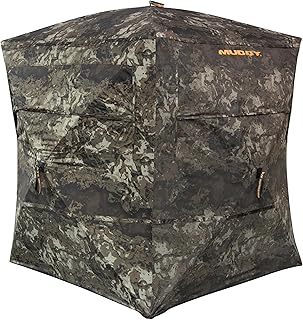
Muddy Outdoors Prevue EVO MAX:
Versatile, quick to put up, and with adjustable windows. It’s mid-priced and offers plenty of space for gear.
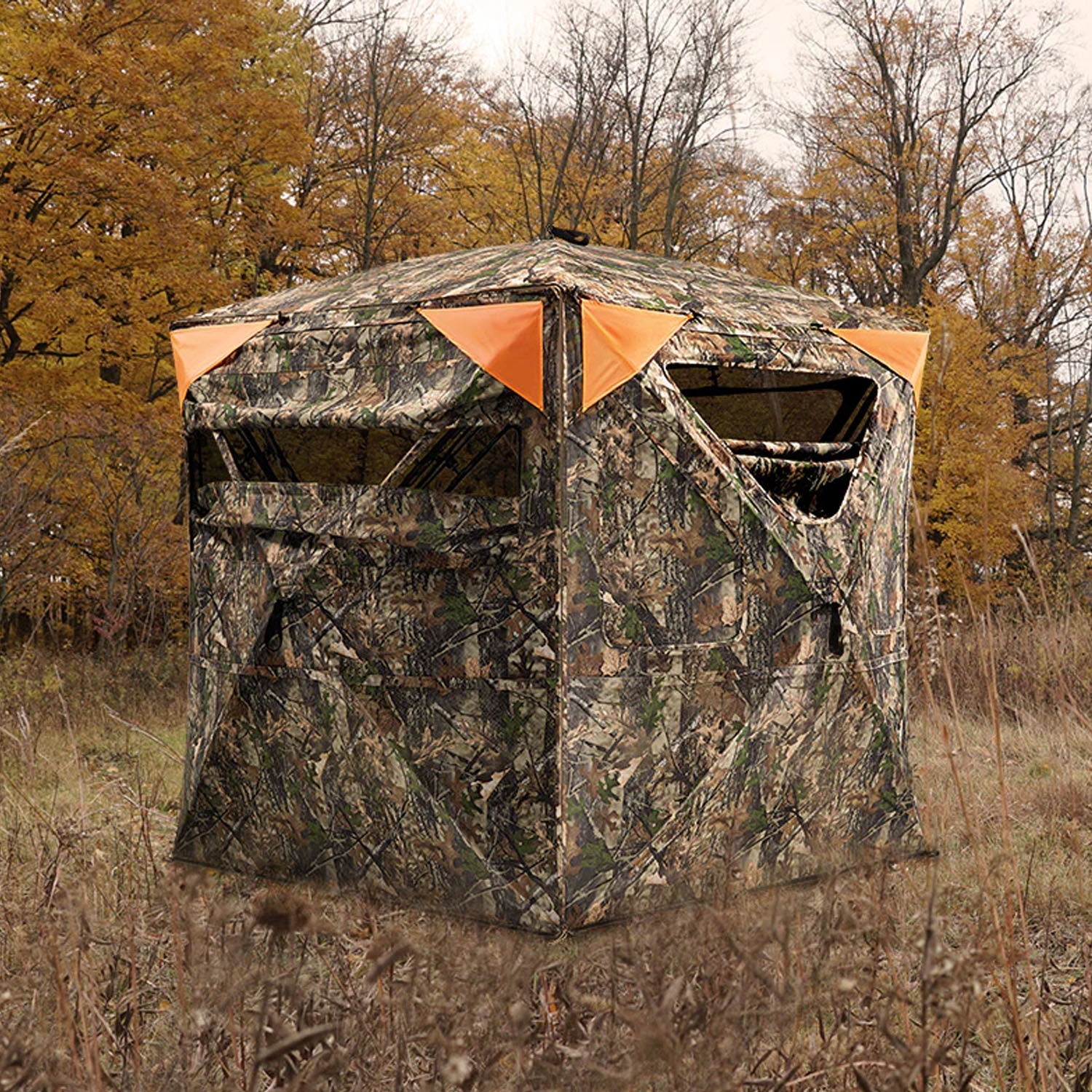
Tidewe See Through Hunting Blind:
The clear mesh panels are a game changer for spotting movement outside. This blind is lightweight and affordable, though not quite as tough as premium options.
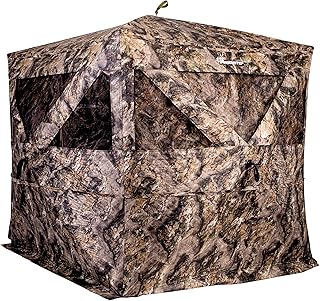
Ameristep Thermal Series Hub Blind:
Built for rough and cold weather, with silent window adjustments and a sturdy frame. It’s pricey but worth it if you’re in for long, hard hunts.
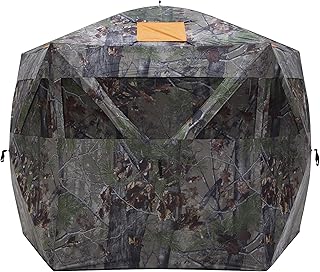
Barronett Feather Five Portable Blind:
Simple and costs less than most, yet great when you need to get set up quickly or hunt in different spots each day.
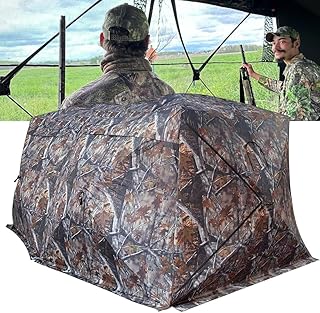
Thunderbay Bunkhouse Portable Blind:
This roomy model is perfect if you carry lots of gear or hunt with a buddy. Good value, with plenty of visibility options.
I always match the camouflage pattern to my hunting area. Double-checking that there’s enough room for myself, my equipment, and a second hunter if needed saves headaches down the road.
More Portable Blind Tips for Elk Success
Elk hunting from a blind can be a waiting game. I’ve come to rely on a few habits that consistently deliver results:
- Practice in the Blind Ahead of Time: I simulate drawing my bow or lifting my rifle while seated in the blind. This checks for snag points, awkward angles, or tight quarters before the moment of truth arrives.
- Stay Patient and Observant: Elk may linger just out of sight or take hours to arrive. I avoid constant distractions and stay alert.
- Manage Scent Carefully: Even in a blind, I use scent elimination sprays, store clothing in scent-proof bags, and avoid opening windows unnecessarily.
- Stay Quiet Getting In and Out: Entry and exit routines matter. I go slow, choose quiet routes, and make sure I’m not pushing my scent upwind into likely elk approaches.
Patience, practice, and strict scent control are the little things that can lead to big elk encounters.
Frequently Asked Questions
Other elk hunters often ask these questions about portable blinds:
What’s the main benefit of using a portable blind for elk?
It hides your movements and scent, making it much easier to bowhunt or set up on open ground where natural cover is limited.
How far ahead of the hunt should I put up my blind?
If I can, I set it out several days in advance. If time’s short, I arrive very early and add natural camouflage to help it blend in right away.
I wear dark, dull clothes and sit back from the windows, only opening them enough to see out and get a shot.
Is a portable blind a good choice for a new elk hunter?
For most, yes. It flattens the learning curve for bowhunting and works for gun hunters too, especially in mixed or unfamiliar terrain.
Final Thoughts on Portable Blinds for Elk Hunting
Using portable blinds for elk hunting has given me more opportunities and made every hunt a bit smarter. Choosing the right blind and setting it up with care can turn an average day into an action-packed one.
Every hunt teaches me something new, and sticking with small changes and checking what works can lead to unforgettable, close-up encounters with elk. Don’t be afraid to adjust tactics as you go; sometimes, the smallest tweaks make the biggest impact.
Most Recent Articles:
- 14 Tips And Tactics For Public Land Mule Deer Hunting

- 6 Features of Waterproof Ground Blinds For Wet-condition Elk Hunting
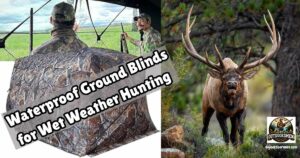
- 4 of the Best DIY Elk Hunting Areas In Colorado

- 8 Tips for Choosing the Best DIY Elk Hunting States

- 5 Hunting Gear Packing List Essentials For DIY Trips

- 7 Tips For Hunting The Elk Migration

As always, stay safe, enjoy the journey, and please try to leave it cleaner than you found it. If you have any comments, questions, ideas, or suggestions, please leave them in the comment section below, and I’ll get back to you ASAP. You can follow us on YouTube: Man Art Creations for videos of our DIY Adventures.
P.S. Thanks so much for checking out our blog; we really appreciate it. Just so you know, we may receive a commission if you click on some of the links that appear on our site. This helps us keep our content free and up-to-date for everyone. We appreciate your support!
